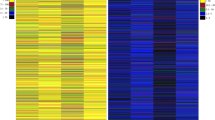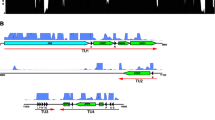Abstract
We have taken advantage of recently sequenced hemiascomycete fungal genomes to computationally identify additional genes potentially regulated by upstream open reading frames (uORFs). Our approach is based on the observation that the structure, including the uORFs, of the post-transcriptionally uORF regulated Saccharomyces cerevisiae genes GCN4 and CPA1 is conserved in related species. Thirty-eight candidate genes for which uORFs were found in multiple species were identified and tested. We determined by 5′ RACE that 15 of these 38 genes are transcribed. Most of these 15 genes have only a single uORF in their 5′ UTR, and the length of these uORFs range from 3 to 24 codons. We cloned seven full-length UTR sequences into a luciferase (LUC) reporter system. Luciferase activity and mRNA level were compared between the wild-type UTR construct and a construct where the uORF start codon was mutated. The translational efficiency index (TEI) of each construct was calculated to test the possible regulatory function on translational level. We hypothesize that uORFs in the UTR of RPC11, TPK1, FOL1, WSC3, and MKK1 may have translational regulatory roles while uORFs in the 5′ UTR of ECM7 and IMD4 have little effect on translation under the conditions tested.




Similar content being viewed by others
References
Albrecht G, Mosch HU, Hoffmann B, Reusser U, Braus GH (1998) Monitoring the Gcn4 protein-mediated response in the yeast Saccharomyces cerevisiae. J Biol Chem 273:12696–12702
Altschul SF, Gish W, Miller W, Myers EW, Lipman DJ (1990) Basic local alignment search tool. J Mol Biol 215:403–410
Brachat S, Dietrich FS, Voegeli S, Zhang Z, Stuart L, Lerch A, Gates K, Gaffney T, Philippsen P (2003) Reinvestigation of the Saccharomyces cerevisiae genome annotation by comparison to the genome of a related fungus: Ashbya gossypii. Genome Biol 4:R45
Brown CY, Mize GJ, Pineda M, George DL, Morris DR (1999) Role of two upstream open reading frames in the translational control of oncogene mdm2. Oncogene 18:5631–5637
Chedin S, Riva M, Schultz P, Sentenac A, Carles C (1998) The RNA cleavage activity of RNA polymerase III is mediated by an essential TFIIS-like subunit and is important for transcription termination. Genes Dev 12:3857–3871
Cherry JM, Ball C, Weng S, Juvik G, Schmidt R, Adler C, Dunn B, Dwight S, Riles L, Mortimer RK, Botstein D (1997) Genetic and physical maps of Saccharomyces cerevisiae. Nature 387:67–73
Cliften P, Sudarsanam P, Desikan A, Fulton L, Fulton B, Majors J, Waterston R, Cohen BA, Johnston M (2003) Finding functional features in Saccharomyces genomes by phylogenetic footprinting. Science 301:71–76
Dietrich FS, Voegeli S, Brachat S, Lerch A, Gates K, Steiner S, Mohr C, Pohlmann R, Luedi P, Choi S, Wing RA, Flavier A, Gaffney TD, Philippsen P (2004) The Ashbya gossypii genome as a tool for mapping the ancient Saccharomyces cerevisiae genome. Science 304:304–307
Dujon B, Sherman D, Fischer G, Durrens P, Casaregola S, Lafontaine I, De Montigny J, Marck C, Neuveglise C, Talla E, Goffard N, Frangeul L, Aigle M, Anthouard V, Babour A, Barbe V, Barnay S, Blanchin S, Beckerich JM, Beyne E, Bleykasten C, Boisrame A, Boyer J, Cattolico L, Confanioleri F, De Daruvar A, Despons L, Fabre E, Fairhead C, Ferry-Dumazet H, Groppi A, Hantraye F, Hennequin C, Jauniaux N, Joyet P, Kachouri R, Kerrest A, Koszul R, Lemaire M, Lesur I, Ma L, Muller H, Nicaud JM, Nikolski M, Oztas S, Ozier-Kalogeropoulos O, Pellenz S, Potier S, Richard GF, Straub ML, Suleau A, Swennen D, Tekaia F, Wesolowski-Louvel M, Westhof E, Wirth B, Zeniou-Meyer M, Zivanovic I, Bolotin-Fukuhara M, Thierry A, Bouchier C, Caudron B, Scarpelli C, Gaillardin C, Weissenbach J, Wincker P, Souciet JL (2004) Genome evolution in yeasts. Nature 430:35–44
Gaba A, Wang Z, Krishnamoorthy T, Hinnebusch AG, Sachs MS (2001) Physical evidence for distinct mechanisms of translational control by upstream open reading frames. EMBO J 20:6453–6463
Gerstel B, McCarthy JE (1989) Independent and coupled translational initiation of atp genes in Escherichia coli: experiments using chromosomal and plasmid-borne lacZ fusions. Mol Microbiol 3:851–859
Goyer C, Altmann M, Lee HS, Blanc A, Deshmukh M, Woolford JL Jr, Trachsel H, Sonenberg N (1993) TIF4631 and TIF4632: two yeast genes encoding the high-molecular-weight subunits of the cap-binding protein complex (eukaryotic initiation factor 4F) contain an RNA recognition motif-like sequence and carry out an essential function. Mol Cell Biol 13:4860–4874
Hampsey M (1998) Molecular genetics of the RNA polymerase II general transcriptional machinery. Microbiol Mol Biol Rev 62:465–503
Harigai M, Miyashita T, Hanada M, Reed JC (1996) A cis-acting element in the BCL-2 gene controls expression through translational mechanisms. Oncogene 12:1369–1374
Hashimoto S, Suzuki Y, Kasai Y, Morohoshi K, Yamada T, Sese J, Morishita S, Sugano S, Matsushima K (2004) 5′-end SAGE for the analysis of transcriptional start sites. Nat Biotechnol 22:1146–1149
van den Heuvel JJ, Bergkamp RJ, Planta RJ, Raue HA (1989) Effect of deletions in the 5′-noncoding region on the translational efficiency of phosphoglycerate kinase mRNA in yeast. Gene 79:83–95
Hinnebusch AG (1997) Translational regulation of yeast GCN4. A window on factors that control initiator-tRNA binding to the ribosome. J Biol Chem 272:21661–21664
Ho SN, Hunt HD, Horton RM, Pullen JK, Pease LR (1989) Site-directed mutagenesis by overlap extension using the polymerase chain reaction. Gene 77:51–59
Hoffmann B, Valerius O, Andermann M, Braus GH (2001) Transcriptional autoregulation and inhibition of mRNA translation of amino acid regulator gene cpcA of filamentous fungus Aspergillus nidulans. Mol Biol Cell 12:2846–2857
Holstege FC, Jennings EG, Wyrick JJ, Lee TI, Hengartner CJ, Green MR, Golub TR, Lander ES, Young RA (1998) Dissecting the regulatory circuitry of a eukaryotic genome. Cell 95:717–728
Iizuka N, Najita L, Franzusoff A, Sarnow P (1994) Cap-dependent and cap-independent translation by internal initiation of mRNAs in cell extracts prepared from Saccharomyces cerevisiae. Mol Cell Biol 14:7322–7330
Kellis M, Patterson N, Endrizzi M, Birren B, Lander ES (2003) Sequencing and comparison of yeast species to identify genes and regulatory elements. Nature 423:241–254
Kellis M, Birren BW, Lander ES (2004) Proof and evolutionary analysis of ancient genome duplication in the yeast Saccharomyces cerevisiae. Nature 428:617–624
Komar AA, Lesnik T, Cullin C, Merrick WC, Trachsel H, Altmann M (2003) Internal initiation drives the synthesis of Ure2 protein lacking the prion domain and affects [URE3] propagation in yeast cells. EMBO J 22:1199–1209
Kozak M (2002) Pushing the limits of the scanning mechanism for initiation of translation. Gene 299:1–34
Lodder AL, Lee TK, Ballester R (1999) Characterization of the Wsc1 protein, a putative receptor in the stress response of Saccharomyces cerevisiae. Genetics 152:1487–1499
McIntosh EM, Haynes RH (1986) Sequence and expression of the dCMP deaminase gene (DCD1) of Saccharomyces cerevisiae. Mol Cell Biol 6:1711–1721
Messenguy F, Vierendeels F, Pierard A, Delbecq P (2002) Role of RNA surveillance proteins Upf1/CpaR, Upf2 and Upf3 in the translational regulation of yeast CPA1 gene. Curr Genet 41:224–231
Miyasaka H (1999) The positive relationship between codon usage bias and translation initiation AUG context in Saccharomyces cerevisiae. Yeast 15:633–637
Oliveira CC, van den Heuvel JJ, McCarthy JE (1993) Inhibition of translational initiation in Saccharomyces cerevisiae by secondary structure: the roles of the stability and position of stem-loops in the mRNA leader. Mol Microbiol 9:521–532
Pestova TV, Kolupaeva VG, Lomakin IB, Pilipenko EV, Shatsky IN, Agol VI, Hellen CU (2001) Molecular mechanisms of translation initiation in eukaryotes. Proc Natl Acad Sci USA 98:7029–7036
Polymenis M, Schmidt EV (1997) Coupling of cell division to cell growth by translational control of the G1 cyclin CLN3 in yeast. Genes Dev 11:2522–2531
Ruiz-Echevarria MJ, Peltz SW (2000) The RNA binding protein Pub1 modulates the stability of transcripts containing upstream open reading frames. Cell 101:741–751
Schumperli D, McKenney K, Sobieski DA, Rosenberg M (1982) Translational coupling at an intercistronic boundary of the Escherichia coli galactose operon. Cell 30:865–871
Sherman D, Durrens P, Beyne E, Nikolski M, Souciet JL (2004) Genolevures: comparative genomics and molecular evolution of hemiascomycetous yeasts. Nucleic Acids Res 32(Database issue):D315–D318
Shiraki T, Kondo S, Katayama S, Waki K, Kasukawa T, Kawaji H, Kodzius R, Watahiki A, Nakamura M, Arakawa T, Fukuda S, Sasaki D, Podhajska A, Harbers M, Kawai J, Carninci P, Hayashizaki Y (2003) Cap analysis gene expression for high-throughput analysis of transcriptional starting point and identification of promoter usage. Proc Natl Acad Sci USA 100:15776–15781
Steel LF, Telly DL, Leonard J, Rice BA, Monks B, Sawicki JA (1996) Elements in the murine c-mos messenger RNA 5′-untranslated region repress translation of downstream coding sequences. Cell Growth Differ 7:1415–1424
Vattem KM, Wek RC (2004) Reinitiation involving upstream ORFs regulates ATF4 mRNA translation in mammalian cells. Proc Natl Acad Sci USA 101:11269–11274
Verge V, Vonlanthen M, Masson JM, Trachsel H, Altmann M (2004) Localization of a promoter in the putative internal ribosome entry site of the Saccharomyces cerevisiae TIF4631 gene. RNA 10:277–286
Verna J, Lodder A, Lee K, Vagts A, Ballester R (1997) A family of genes required for maintenance of cell wall integrity and for the stress response in Saccharomyces cerevisiae. Proc Natl Acad Sci USA 94:13804–13809
Vilela C, McCarthy JE (2003) Regulation of fungal gene expression via short open reading frames in the mRNA 5′ untranslated region. Mol Microbiol 49:859–867
Vilela C, Linz B, Rodrigues-Pousada C, McCarthy JE (1998) The yeast transcription factor genes YAP1 and YAP2 are subject to differential control at the levels of both translation and mRNA stability. Nucleic Acids Res 26:1150–1159
Vilela C, Ramirez CV, Linz B, Rodrigues-Pousada C, McCarthy JE (1999) Post-termination ribosome interactions with the 5′ UTR modulate yeast mRNA stability. EMBO J 18:3139–3152
Wang Z, Sachs MS (1997) Ribosome stalling is responsible for arginine-specific translational attenuation in Neurospora crassa. Mol Cell Biol 17:4904–4913
Washburn MP, Koller A, Oshiro G, Ulaszek RR, Plouffe D, Deciu C, Winzeler E, Yates JR III (2003) Protein pathway and complex clustering of correlated mRNA and protein expression analyses in Saccharomyces cerevisiae. Proc Natl Acad Sci USA 100:3107–3112
Wei CL, Ng P, Chiu KP, Wong CH, Ang CC, Lipovich L, Liu ET, Ruan Y (2004) 5′ Long serial analysis of gene expression (LongSAGE) and 3′ LongSAGE for transcriptome characterization and genome annotation. Proc Natl Acad Sci USA 101:11701–11706
Werner M, Feller A, Messenguy F, Pierard A (1987) The leader peptide of yeast gene CPA1 is essential for the translational repression of its expression. Cell 49:805–813
Wojda I, Alonso-Monge R, Bebelman JP, Mager WH, Siderius M (2003) Response to high osmotic conditions and elevated temperature in Saccharomyces cerevisiae is controlled by intracellular glycerol and involves coordinate activity of MAP kinase pathways. Microbiology 149:1193–1204
Zhang Z, Dietrich FS (2003) Verification of a new gene on Saccharomyces cerevisiae chromosome III. Yeast 20:731–738
Zhang Z, Dietrich FS (2005) Mapping of transcription start sites in Saccharomyces cerevisiae using 5′ SAGE. Nucleic Acids Res 33:2838–2851
Zhou W, Edelman GM, Mauro VP (2001) Transcript leader regions of two Saccharomyces cerevisiae mRNAs contain internal ribosome entry sites that function in living cells. Proc Natl Acad Sci USA 98:1531–1536
Acknowledgements
We thank John E.G. McCarthy at UMIST for providing YCp22FL series plasmids. We thank Joe Heitman for providing yeast strains and Miguel Arevalo-Rodriguez, Shihua Lu, and Carol Gallione for valuable technical help and advice. We are grateful to Joe Heitman, John McCusker, Douglas Marchuk, and Bryan Cullen and for generously providing laboratory facilities and comments on the whole project. The authors also thank Mark DeLong for his careful reading and revising of the manuscript.
Author information
Authors and Affiliations
Corresponding author
Additional information
Communicated by S. Hohmann
Electronic supplementary material
Rights and permissions
About this article
Cite this article
Zhang, Z., Dietrich, F.S. Identification and characterization of upstream open reading frames (uORF) in the 5′ untranslated regions (UTR) of genes in Saccharomyces cerevisiae . Curr Genet 48, 77–87 (2005). https://doi.org/10.1007/s00294-005-0001-x
Received:
Revised:
Accepted:
Published:
Issue Date:
DOI: https://doi.org/10.1007/s00294-005-0001-x




